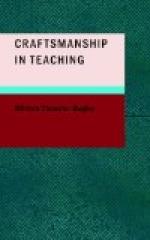III
Fundamentally, there is, I believe, no discrepancy, no inconsistency, between the scientific spirit in education and what may be called the philosophical spirit. As I have suggested, there are always two dangers that must be avoided: the danger, in the first place, of thinking of the old as essentially bad; and, on the other hand, the danger of thinking of the new and strange and unknown as essentially bad; the danger of confusing a sound conservatism with a blind worship of established custom; and the danger of confusing a sound radicalism with the blind worship of the new and the bizarre.
Let me give you an example of what I mean. There is a rather bitter controversy at present between two factions of science teachers. One faction insists that physics and chemistry and biology should be taught in the high school from the economic point of view,—that the economic applications of these sciences to great human arts, such as engineering and agriculture, should be emphasized at every point,—that a great deal of the material now taught in these sciences is both useless and unattractive to the average high-school pupil. The other faction maintains that such a course would mean the destruction of science as an integral part of the secondary culture course,—that science to be cultural must be pure science,—must be viewed apart from its economic applications,—apart from its relations to the bread-and-butter problem.
Now many of the advocates of the first point of view—many of the people that would emphasize the economic side—are animated by the spirit of change and unrest which dominates our latter-day civilization. They wish to follow the popular demand. “Down with scholasticism!” is their cry; “Down with this blind worship of custom and tradition! Let us do the thing that gives the greatest immediate benefit to our pupils. Let us discard the elements in our courses that are hard and dry and barren of practical results.” Now these men, I believe, are basing their argument upon the fallacy of immediate expediency. The old is bad, the new is good. That is their argument. They have no sheet anchor out to windward. They are willing to drift with the gale.
Many of the advocates of the second point of view—many of the people who hold to the old line, pure-science teaching—are, on the other hand, animated by a spirit of irrational conservatism. “Down with radicalism!” they shout; “Down with the innovators! Things that are hard and dry are good mental discipline. They made our fathers strong. They can make our children strong. What was good enough for the great minds of the past is good enough for us.”




